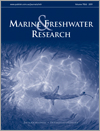Spatially competitive bioeroding sponges are thought to be potential beneficiaries from reef degradation. However, we still know reasonably little about what influences their recruitment. We monitored recruitment patterns in a 2-year deployment of experimental substrate blocks on Indonesian reefs. Recruitment was observed across the majority of blocks and was driven primarily by the proximity of adult sponges and hydrodynamics.

Marine and Freshwater Research
Volume 70 Number 6 2019
MF18011Carbon chemistry variability around a tropical archipelago
Oceanic islands are considered oases surrounded by a blue desert, with higher biodiversity and primary production. This is because islands act as a barrier to marine current flow, creating small upwellings. This study investigated how this process affects carbon chemistry distribution around the Fernando de Noronha Archipelago (Brazil). The results support the occurrence of a rising of subsurface water, which results in a significant increase in phytoplankton biomass, and strong thermohaline gradient controlling carbonate system variability.
MF18239Comparing static and dynamic flood models in estuarine environments: a case study from south-east Australia
Coastal flooding triggered by storm surges poses a severe threat to coastal communities, particularly in estuaries. This study compares the performance of flood mapping approaches of differing complexity across two estuaries of contrasting geomorphology. Modelling results indicate that certain estuaries require complex modelling techniques to accurately map flooding, whereas other estuaries may be modelled using simpler approaches. Geomorphological characteristics of estuaries may guide which flood mapping approach to use.
MF18244Occurrence characteristics of harmful and non-harmful algal species related to coastal environments in the southern sea of Korea
The coastal environment is fairly complicated and ever changing; thus, it is very difficult to predict the HAB phenomena. To better understand the ecological dynamics of phytoplankton, complex physical, chemical and biological surveys should be performed together. Geographical dynamics of nutrient, water temperature and salinity are essential parameters in determining the phytoplankton community in coastal environments.
MF18237Importance of tussocks in supporting plant diversity in Carex schmidtii Meinsh. wetlands
Tussocks created by Carex schmidtii in sedge meadows may be able to support biodiversity because of their structural complexity. We found that tussocks enhance species richness by increasing surface area, and support a diversity of co-occurring species by creating at least two distinct microhabitats. Our findings will have important applications in diversity enhancement in restoration projects.
MF18305Diet of juvenile Galaxias maculatus (Galaxiidae) during the upstream migration period in the lower Waikato River, New Zealand
Within New Zealand’s longest river, juveniles of the Southern Hemisphere fish Galaxias maculatus were shown to preferentially consume large Cladocera over smaller zooplankton groups, and to predominantly feed on Cladocera following spring high flows. At this time, it is thought that inflows from lake–wetlands and adjacent inundated flood plains supplemented riverine food resources, potentially providing an important trophic subsidy to sustain upstream migration.
MF18345Prey consumption estimates for salmon sharks
Top predators, such as salmon sharks (Lamna ditropis), can influence the abundance and population structure of organisms at lower trophic levels. Much uncertainty remains around per capita consumption rates of salmon sharks, but bioenergetic accounting methods produce estimates of between 1610 and 2070 kg year–1 depending on assumed diet, suggesting that these sharks have similar energetic requirements to piscivorous marine mammals.
MF18141Life history of the common blacktip shark, Carcharhinus limbatus, from central eastern Australia and comparative demography of a cryptic shark complex
 , Stephen M. Taylor
, Stephen M. Taylor  and Pascal T. Geraghty
and Pascal T. Geraghty
This is the first detailed study of the life history of Carcharhinus limbatus from Australia. C. limbatus attained a larger size, matured later and lived longer than its morphologically similar and sympatric congener, Carcharhinus tilstoni. The two species are likely to have divergent responses to fishing, highlighting the importance of species-specific fisheries monitoring.
MF17318Distribution of epipelic algae and related environmental nutrients in Taihu Lake, revealed by HPLC analysis
Although epipelic algae play a pivotal role in shallow lakes, their community composition has not been studied extensively. This study is among the first to explore epipelic algae in Taihu Lake using HPLC analysis, and found that the epiphytic algal community varied over time and space. The variation in epipelic algae was related to the heterogeneity of environmental factors.
MF18347Phylogeography and species delimitation of Cherax destructor (Decapoda: Parastacidae) using genome-wide SNPs
The yabby is an iconic Australian freshwater crustacean that has been an important species to humans for thousands of years. We examined genetic variation in populations of yabby covering their entire native distribution across the Lake Eyre Basin, Murray–Darling Basin and western Victoria. Genetic data support the current species-level taxonomy, the distinctiveness of recognised subspecies and the existence of one undescribed species.
This study compared fishes seen from baited videos positioned on the bottom and in the water column in three places. Assemblages observed from these two positions were different even in water as shallow as 7 m, with many species only seen from one position. Studies aiming for complete assemblages would benefit from using both positions to complement one another.
MF18232Cyprinid passage performance in an experimental multislot fishway across distinct seasons
New fishway solutions are required to restore river connectivity for fish communities. Recently, a multislot fishway was developed with two consecutive vertical slots. This study assessed the effectiveness of this fishway for two cyprinid species in different seasons. The results show differences in passage performance between species and seasons. Overall, this fishway was considered a cost-effective design for cyprinids with different ecological traits.
MF18368Effects of tag type, morphological location and tagger experience on tag retention rates in freshwater fishes
We present the first in-depth examination of tag rejection for warm water freshwater fishes in Australia, and show that rejection rates depend on where the tag is implanted, tagger experience and the species of interest. Our results will help guide future programs using recapture to estimate population size.



